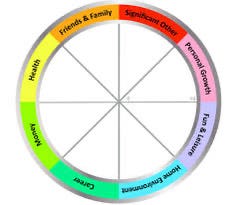How are you?
You’ve probably been asked that question more times than you can count. Most often you’ll simply say, “Fine”, even when that’s not the case. You may not know what to say. Saying “Great!” feels like a stretch while saying “Not so good.” doesn't feel right either. Maybe you’re feeling somewhere in between and you’re not sure why. You’re not even sure how to describe what you're feeling other than saying, “I feel out of sorts.”
It’s quite normal to feel out of sorts, at times. You may be stressed from work or family obligations. Perhaps it’s financial stress or poor health. Maybe you have doubts about your current relationship or you're just not having enough fun. Whatever it is, you know in your gut that you’re not operating in an optimal fashion. If you’re struggling with achieving balance - if you’re feeling out of whack - it may be time to give the wheel a spin. What wheel am I talking about? That would be the “Wheel of Life”.
The Wheel of Life
The Wheel of Life, a favorite tool of life coaches, was developed in 1960 by Paul J. Meyer, the founder of Success Motivation Institute and an important figure in the field of self-improvement (Swart, 2022). The Wheel of Life has been modified dozens of times over the years to suit different circumstances. The original wheel contained 8 categories:
business/career
finances
health
family and friends
romance/relationships
personal growth
recreation
physical environment
The model below is based upon Meyer’s original concept (French, 2019).
A life coach working with a client would use this tool collaboratively. However, once you're familiar with the concept, it’s something you can do on your own and revisit from time to time, as needed.
Step by Step
The first step a coach may take when working with the Wheel of Life is to review each category with the client to see if any modifications are needed. Clients may want to eliminate some categories and replace them with others. For example, if the client is retired, having a category for “Career” may not make sense. At times it may be useful to divide categories. One category that is frequently subdivided is “Health”. Some clients may prefer two separate categories, “Physical Health” and “Mental Health” while other clients may want to break it down even further. “Physical Health” is often broken into “Nutrition” and “Fitness”. The beauty of working with the Wheel of Life is that it can be modified to suit an individual’s specific circumstances. Once you’ve agreed upon the categories in the Wheel, it’s time to become introspective.
With the categories set, the client can proceed to the task of rating their life in each on a scale of 1 to 10, with a “1” indicating the lowest score (least satisfied) and a “10” being reserved for the highest score (fully satisfied). This requires introspection on the part of the client. Once the client has assigned a number to each category, the results can be shared with the coach. As the coach and client discuss the rationale behind each score, the coach may ask the client some of the following questions:
How is this category important to you?
Are you satisfied with the current score?
Are you surprised by the score?
What would it take to get a higher score?”
Are there obstacles or barriers interfering with attaining the higher score?
What specific actions can you take to improve in this area?
How would improvement in this area impact the overall quality of your life?
Once the score in each category is reviewed, the client can determine which areas need the most attention. Choosing two or three areas to work on initially would be the best approach. If a client tries to take too many actions in too many areas simultaneously, it’s easy to become overwhelmed, making the entire endeavor counterproductive. In addition, when identifying a path forward, utilizing the SMART goal model may be beneficial. For example, if your goal is to improve your score in “Personal Growth” and “Recreation”, be certain to outline actions that are specific, measurable, attainable, relevant, and timebound (Doran, 1981).
Conclusion
The Wheel of Life is a simple tool that’s easy to use and revisit. You don’t need to be working with a life coach to give it a try. If you choose to complete the Wheel of Life, be certain to save your results. Then, when you revisit it in the future, you’ll be able to measure your progress. Understanding the areas of your life that need work, and developing an action plan to get there, will bring you closer to realizing that best version of yourself. You’ll be able to bridge the gap between goals and achievement, between life in reality and the life you dream about.
.
Works Cited
Doran, G.T. (1981). There’s a SMART way to write management’s goals and objectives. Journal
of Management Review, 70, 35-36.
French, Anne. (2019). Wheel of life. Coast Clinic.
Swart, Joan. (2022). The wheel of as a coaching tool to audit life’s priorities. ResearchGate.




